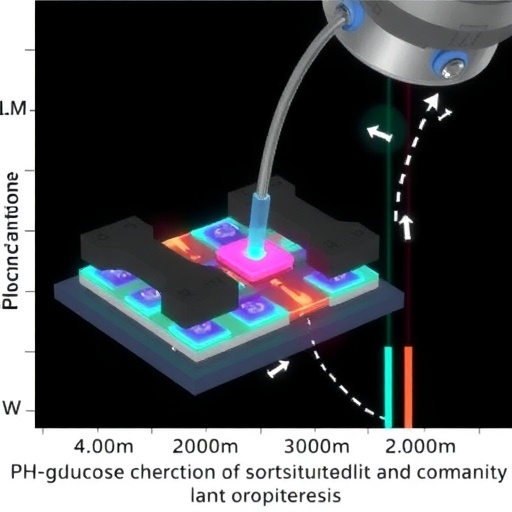In a groundbreaking study published in the International Journal of Mental Health and Addiction, researchers have embarked on an ambitious exploration of the intricate web linking non-suicidal self-injury (NSSI) and substance abuse among college students. Titled “Unraveling the Network of Relationships Between Non-suicidal Self-Injury and Substance Abuse Among College Students: Findings from the Flemish College Students’ Mental Health Survey,” this research unveils detailed patterns and associations that could reshape how mental health professionals approach these co-occurring behaviors in emerging adults. The Flemish region’s college population served as the focus group, providing a substantial dataset for analyzing the psychological and behavioral intersections of self-injury and substance misuse.
The study addresses a critical gap often present in mental health research—understanding co-morbid behaviors within populations vulnerable to psychological distress. Non-suicidal self-injury, defined as the deliberate, self-inflicted damage to one’s body without suicidal intent, has long perplexed clinicians and researchers due to its multifaceted origins and manifestations. Substance abuse, on the other hand, encompasses the harmful consumption of alcohol or drugs, often employed as maladaptive coping mechanisms. The researchers hypothesize that these behaviors are not isolated but exist within complex networks influenced by psychological, emotional, and social stressors. The goal is to conceptually and empirically disentangle this complexity using a novel network analysis approach.
Network analysis, a methodological framework borrowed from graph theory and complex systems science, allows for the visualization and quantification of interdependent relationships between multiple variables. In the context of this study, the authors mapped how various psychological symptoms, environmental factors, and behavioral outcomes interact to influence NSSI and substance use patterns. This framework transcends traditional linear models, offering richer insights into possible causality, mediating factors, and feedback loops that sustain the co-occurrence of self-injurious behavior and substance abuse in students. Such granular understanding is pivotal for designing tailored interventions that address root causes rather than symptoms in isolation.
The data derived from the Flemish College Students’ Mental Health Survey provides a robust empirical foundation for this investigation, drawing on a diverse sample that includes variables such as demographic information, psychological distress levels, substance use habits, and self-injury records. The incorporation of a large, representative dataset enhances the generalizability of the findings and bolsters statistical power. More importantly, the survey’s detailed psychometric instruments allow for precise quantification of variables like anxiety, depression, impulsivity, and trauma history, all of which frame the broader behavioral landscape contributing to NSSI and substance misuse.
One of the central findings reveals that self-injury and substance abuse act as interconnected behaviors within a broader psychological network, rather than functioning independently. The study identifies specific nodes—psychological symptoms and behavioral tendencies—that serve as critical bridges between NSSI and substance misuse. For example, impulsivity emerges as a significant mediator, amplifying the risk for both behaviors concurrently. Emotional dysregulation, characterized by difficulty managing intense negative emotions, also figures prominently as a shared underpinning of self-injury and substance usage patterns. These results accentuate the importance of addressing these overlapping vulnerabilities in mental health interventions.
Moreover, the study highlights the bi-directional nature of the relationship between NSSI and substance abuse. Instead of viewing substance use as merely a consequence or vice versa, findings suggest a dynamic reciprocal influence. Substance abuse may exacerbate emotional regulation difficulties, thus precipitating self-injurious behavior, while repetitive self-harm may intensify psychological distress, prompting increased substance consumption as a form of temporary relief. This cyclical reinforcement underscores the need for integrated treatment approaches that concurrently target multiple aspects of an individual’s mental health profile.
The implications for college student populations are profound, given the heightened susceptibility to mental health crises during this developmental period. The transition to adulthood often encompasses academic pressures, social challenges, and identity formation—all potential triggers for maladaptive coping mechanisms such as NSSI and substance abuse. By elucidating the networked relationships among these factors, the research paves the way for college counseling centers and healthcare providers to implement early detection systems that identify students at high risk, offering timely, evidence-based support tailored to their unique psychological networks.
Furthermore, the study elucidates the contextual impact of environmental stressors, including academic stress and social isolation, on the prevalence and severity of NSSI and substance abuse. These contextual variables integrate seamlessly into the network model, further complicating the interplay of individual and external influences. It becomes evident that interventions must consider not only personal psychological profiles but also institutional and societal factors that can mitigate or exacerbate risk. For example, peer support programs and stress management workshops could serve as protective factors within the broader network.
Technically, the researchers employed advanced statistical techniques such as Gaussian Graphical Models (GGMs) and regularized partial correlation networks to capture the nuanced interrelations among variables. These methodologies permit the identification of conditional dependencies and the exclusion of spurious associations, thus enhancing the robustness of the network. The application of such rigorous analytic tools signals a methodological advancement in epidemiological mental health research and sets a benchmark for future studies exploring complex behavioral comorbidities.
Crucially, the findings challenge the conventional siloed treatment frameworks that often overlook the interconnectedness of self-injurious behaviors and substance use disorders. Mental health practitioners are encouraged to adopt comprehensive assessment protocols that evaluate a constellation of symptoms and behaviors rather than focusing narrowly on one dimension. This holistic approach can facilitate the development of personalized care plans that simultaneously target emotional dysregulation, impulsivity, trauma-related symptoms, and maladaptive coping strategies.
The research also opens avenues for digital intervention platforms, which can utilize the network analysis model to tailor real-time support for college students. Mobile health applications, for example, could incorporate algorithms sensitive to the emergence of risk patterns within an individual’s psychological network, prompting timely interventions before behaviors escalate. Such technology-driven solutions represent a promising frontier for mental health care, especially for young adults in digitally connected environments.
Another noteworthy aspect is the cross-cultural relevance of the findings, as the Flemish college student demographic may share universal features with student populations globally. While cultural nuances inevitably shape mental health experiences, the core psychological mechanisms of impulsivity and emotional dysregulation appear to transcend borders. Consequently, mental health policies and programs worldwide can benefit from integrating these insights to develop targeted, culturally sensitive prevention and intervention strategies for at-risk youth.
Ethical considerations are also foregrounded by this research. The sensitive nature of self-injury and substance abuse necessitates confidentiality and destigmatization. The study advocates for mental health campaigns that reduce judgment and promote open dialogues on these often-taboo subjects. Such initiatives are integral to fostering environments where students feel safe seeking help without fear of discrimination or repercussions.
In summary, the study conducted by Azadfar, Roland, Baetens, and colleagues represents a vital leap forward in understanding the complex, intertwined nature of non-suicidal self-injury and substance abuse among college students. By deploying sophisticated network analysis on a comprehensive mental health survey dataset, the research delineates key psychological and environmental factors that knit these behaviors together. The insights garnered have far-reaching implications for mental health sciences, clinical practice, and public health policies aimed at early identification, prevention, and integrated treatment of these pervasive issues.
As the prevalence of mental health challenges among young adults continues to rise, this study underscores the urgent necessity for innovative research methodologies and collaborative approaches across disciplines. The network perspective championed here not only illuminates the multifactorial etiology of co-occurring mental health problems but also provides a blueprint for crafting nuanced, effective interventions. Ultimately, this work paves the way for enhanced well-being and improved outcomes for college students grappling with the dual burdens of self-injury and substance abuse.
Subject of Research:
Relationship between non-suicidal self-injury and substance abuse among college students using network analysis.
Article Title:
Unraveling the Network of Relationships Between Non-suicidal Self-Injury and Substance Abuse Among College Students: Findings from the Flemish College Students’ Mental Health Survey.
Article References:
Azadfar, Z., Roland, A., Baetens, I. et al. Unraveling the Network of Relationships Between Non-suicidal Self-Injury and Substance Abuse Among College Students: Findings from the Flemish College Students’ Mental Health Survey. International Journal of Mental Health and Addiction (2025). https://doi.org/10.1007/s11469-025-01559-2
Image Credits: AI Generated
DOI: https://doi.org/10.1007/s11469-025-01559-2
Tags: co-occurring behaviors in emerging adultsFlemish College Students’ Mental Health Surveyinterventions for self-injury and substance abusemaladaptive coping mechanisms in studentsmental health research gapsnon-suicidal self-injury among college studentspatterns of self-harm and addictionpsychological and emotional stressors in studentspsychological distress in college populationsrelationships between self-injury and substance misusesubstance abuse and mental healthunderstanding non-suicidal self-injury





